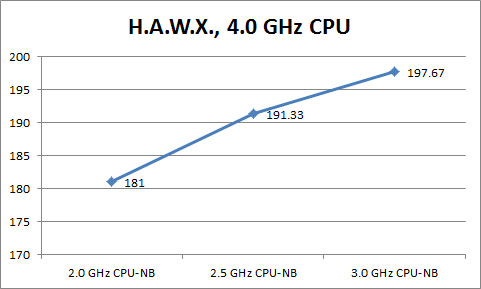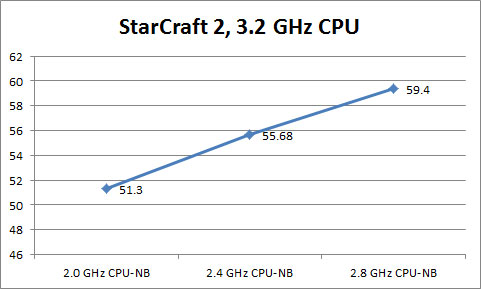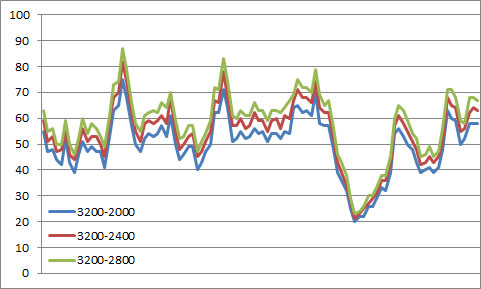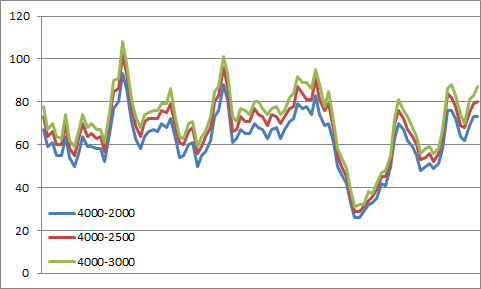ASRock 890FX Deluxe: Comprehensive Motherboard Review & Investigation of Thuban Performance Scaling
by Rajinder Gill on August 31, 2010 7:00 AM EST- Posted in
- ASRock
- AMD
- Motherboards
- 890FX
To find out how the CPU-NB affects the performance, we picked three data points each for our 1090T’s stock frequency (3.2 GHz) and for overclocked frequency (4.0 GHz). Ideally we wanted to control memory ratio, frequencies and timings, but the data size became quickly too large for this review. In the end we decided on some of the key data points so that users can easily understand the impact of the CPU-NB and memory configuration on this platform. For these tests, we disabled Window’s power saving features and 1090T’s Turbo Core. Keep in mind that these tests were not performed as a comparison between different products, so the data here cannot be directly compared to numbers you may see elsewhere. Games were run at 1680x1050 in full-screen mode with maximum in-game settings. AA and AF were disabled.
Stock Configuration (1090T, 3.2 GHz)
3200-2000: CPU 3.2 GHz, 16x200 | CPU-NB 2.0 GHz, 10x200 | 2x2GB DDR3-1066/CL5
3200-2400: CPU 3.2 GHz, 16x200 | CPU-NB 2.4 GHz, 12x200 | 2x2GB DDR3-1333/CL6
3200-2800: CPU 3.2 GHz, 16x200 | CPU-NB 2.8 GHz, 14x200 | 2x2GB DDR3-1600/CL7Overclocked Configuration (1090T, 4.0 GHz)
4000-2000: CPU 4.0 GHz, 16x250 | CPU-NB 2.0 GHz, 8x250 | 2x2GB DDR3-1333/CL6
4000-2500: CPU 4.0 GHz, 16x250 | CPU-NB 2.5 GHz, 10x250 | 2x2GB DDR3-1666/CL7
4000-3000: CPU 4.0 GHz, 16x250 | CPU-NB 3.0 GHz, 12x250 | 2x2GB DDR3-2000/CL8


The 7-Zip benchmark does set the trend of what’s to come. Note we had to stretch the charts in order to keep the numbers legible. It looks like the performance gain is almost linear at 3.2 GHz while it tapers off somewhat as we raise the CPU-NB from 2.5 GHz to 3.0 GHz at the core frequency 4.0 GHz. The improvements from the default CPU-NB frequency 2.0 GHz ring at 3.5% and 5%, respectively.
X264 HD 3.0 Benchmark


We ran the latest version of X264 HD 3.0 benchmark five times, and averaged the middle three scores. X264 HD 3.0 benchmark results are interesting. We see slightly better scaling than 7-Zip for the 1st pass (FPS increases by 4.2% and 5.4%, respectively) , but the improvement in 2nd pass was almost non-existent. We are starting to wonder whether it is worth raising the CPU-NB frequency because the gain pales in comparison to the gain made by increasing the core frequency. Simply overclocking the CPU core by 25% without touching the CPU-NB got us 20% performance improvement in the 2nd pass.
H.A.W.X.


Finally we are seeing some impressive gains. We are using the game’s built-in benchmark at 1680x1050 with in-game graphics options set to maximum in DX9 mode. This game is not known for particularly being CPU-bound, so we are seeing ridiculously high frame rates here. At the same time, the gains made by overclocking the CPU-NB seemed too good to be true, 3.2 GHz CPU / 2.8 GHz CPU-NB combo surpassing 4.0 GHz CPU / 2.0 GHz CPU-NB combo. We ran the benchmark over 10 times on both ASRock’s 890FX Deluxe 4 and the ASUS M4A89GTD Pro/USB3 and the trend was the same, CPU-NB overclocking benefiting the game as much as, if not more than, the CPU core overclocking. Overclocking CPU by 800 MHz nets an 8% improvement in FPS, yet overclocking CPU-NB by 800 MHz got us 9% FPS increase.
This was a completely unexpected result after the 7-Zip and X264 benchmarks, so we had to turn to a game that’s known to be more stressful to CPU. Enter StarCraft 2.
StarCraft 2
This game needs no introduction. We are using a 38 minute replay file and let it play throughout from a player’s point of view to ensure the game data stays in the memory. We then go back and measure the 5 minutes of the battle near the game’s end using FRAPS utility. We set the resolution at 1680x1050 and in-game quality options at maximum.




It was quite disorienting to watch the player’s frantic mouse clicks and keyboard tapping while the camera followed the commands (and 130+ Zerglings). Nevertheless, we had to take many disorienting trips in order to ensure the reliability of our results. We ended up running many more replays countless times and played the game ourselves, and conclude the results are valid.
Both at 3.2 GHz and 4.0 GHz, the CPU-NB overclocking yielded 16% more performance in this game without moving an inch of the CPU frequency. Of course in both the cases the CPU-NB overclocks were massive - 40% at 3.2 GHz and 50% at 4.0 GHz. Whatever conclusion you draw from these tests, one thing is for sure: If your X6 CPU feels sluggish in StarCraft II, overclock its CPU-NB and memory.










42 Comments
View All Comments
jonup - Tuesday, August 31, 2010 - link
Very impressed to see this approach to your testing. I hete when reading an MB reveiw and reach the benchmark section. Same chipsets tend to perform the same. A guess this would be an one-off since in the next review it will be redundant.vol7ron - Tuesday, August 31, 2010 - link
agreed, nice review.Finally - Tuesday, August 31, 2010 - link
I must say that this review was nice to have, I'm much more interested in the 870 Chipset.It's almost identical, except the support of Crossfire, which I have no use for.
RequiemsAllure - Wednesday, September 1, 2010 - link
ahh, but on the ASRock 870 extreme 3 Crossfire is supported.SpaceRanger - Tuesday, August 31, 2010 - link
In the article:USB 3.0 Performance
We use Acronis TrueImage Home (v. 10) to make a backup of our installation drive to an external SATA 3.0 Gbps drive via USB 3.0 and compare it with USB 2.0 and SATA 3.0 Gbps transfers. The total data backed up is approximately 20 GB. We could not complete the backup on the 890GTD Pro/USB3 in a consistent manner.
My Question:
Why were you not able to complete the backup on the 890GTD Pro/USB3? At the conclusion you state :
Is it worth $180 when ASUS 890GTD Pro/USB3 is $30 less? We think the difference largely comes down to the board’s selection of components.
I would call not being able to do a simple backup with the 890GTD enough of a showstopper to not even consider the board. Am I missing something here?
semo - Tuesday, August 31, 2010 - link
I'm also wondering about the SATA3 performance. An issue was identified here on AT with the new 8xx chipset earlier which slowed down SSDs considerably compared to ICH10 controllers. Has this been fixed yet?Kane Y. Jeong - Tuesday, August 31, 2010 - link
Hi,Please check Raja's ASUS M4A89GTD Pro/USB3 review here.
http://www.anandtech.com/show/2959
We purchased another retail M4A89GTD Pro/USB3 off the shelf, and still ran into inconsistent USB 3.0 performance. Sometimes the drives lost connections, and Acronis reported error in the middle of backup process. Success ratio to complete the backup was about 30~40%. An alternative would be to purchase M4A89GTD Pro (not Pro/USB3) for $10 less and go with an add-in card. We did not experience this issue on ASRock 890FX Deluxe 4.
SpaceRanger - Tuesday, August 31, 2010 - link
Thank you for the response. So you're advising getting the Pro (not Pro/USB3) instead of the 890FX? Cause Raja's findings would be enough for me to not want to get it.nbjknk - Thursday, November 25, 2010 - link
Dear customers, thank you for your support of our company.
Here, there's good news to tell you: The company recently
launched a number of new fashion items! ! Fashionable
and welcome everyone to come buy. If necessary, please$$$$$$$$$$__$$$_$$$$$$$$$$$
http://www.vipshops.org
$$_____$$$_$$$_________$$$
$$$_____$$$_$$$______ $$$
$$$ ____$$$_ $$$_____ $$$
$$$$$$$$$$__$$$____$$$
$$$_____$$$_$$$___$$$
$$$_____$$$_$$$__$$$
$$$$$$$$$$$_$$$_$$$
$$$$$$$$$$__$$$_$$$$$$$$$$$$ !::!
http://www.vipshops.org
Thursday, 21 October 2010 at 9:48 PM
optarix12 - Tuesday, August 31, 2010 - link
This is a very nice writeup and relevant to my interests to boot. Thank you for the concise article Kane. Oh, and if you ever figure out why you saw the inexplicable results you should do a part 2!